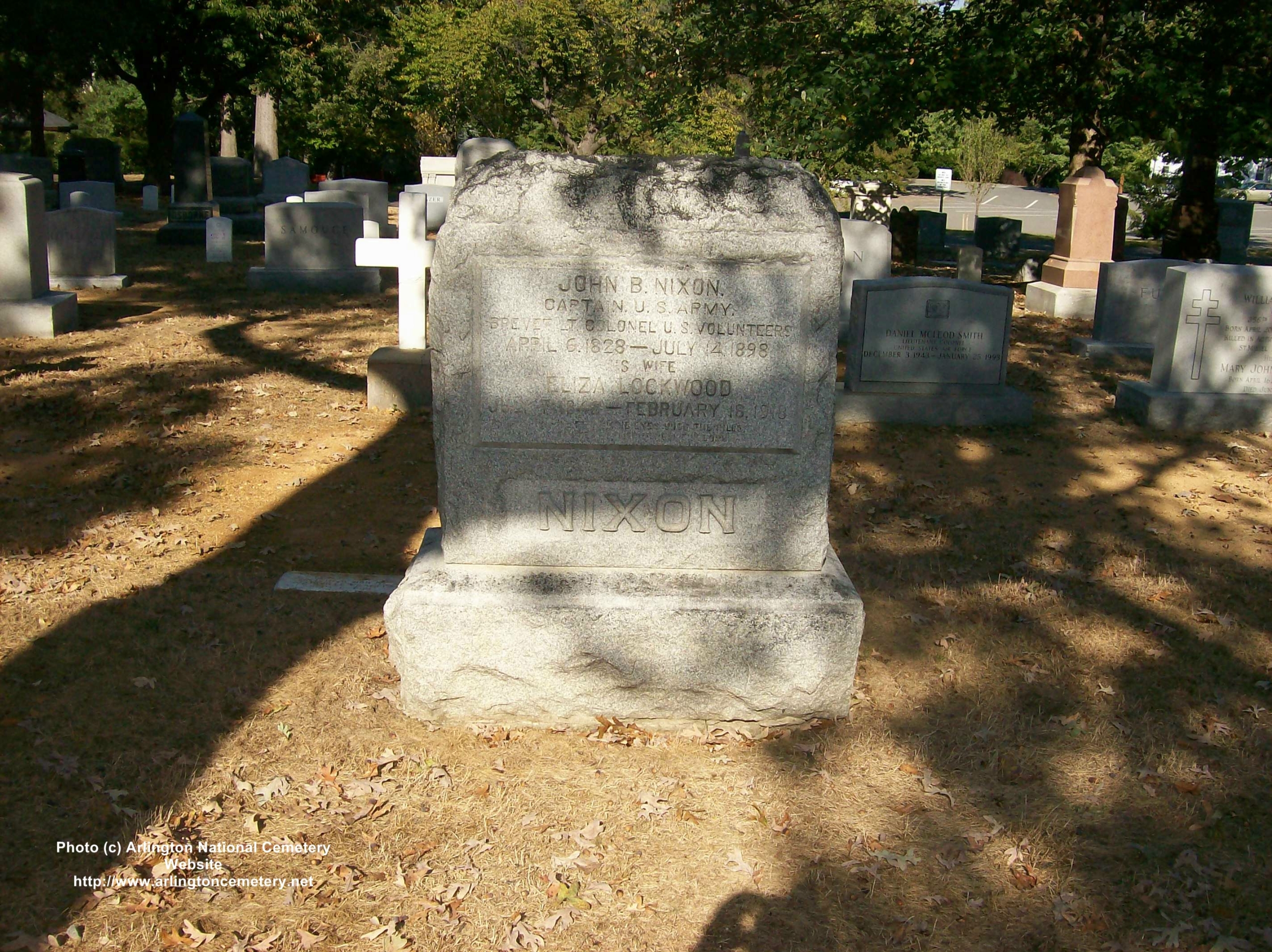John Benton Nixon of Virginia
- Appointed from Illinois, Second Lieutenant, 111th Illinois Volunteer Infantry, 2 September 1862
- First Lieuenant, 20 April 1863
- Captain, 17th U. S. Colored Infantry, 3 December 1863
- Breveted Major and Lieutenant Colonel of U. S. Volunteers, 13 March 1865 for faithful and meritorious services during the war
- Honorably mustered out 3 November 1866
- First Lieutenant, 38th U. S. Infantry, 12 June 1867
- Transferred to 24th U. S. Infantry, 11 November 1869
- Regimental Quartermaster, 1 March 1871 to 5 January 1877
- Captain, 5 January 1877
- Retired 26 November 1884
- Died 14 July 1898
Captain and Brevet Lieutenant Colonel John B. Nixon was born near Boothsville, Harrison County, Virginia, April 6, 1828. His education was obtained in the private schools of that locality, and at Rector College, Pruntytown, Virginia.
In 1855 he removed to Henry County, Illinois, where he held several subordinate county positions, including justice of the peace and postmaster. After the breaking out of the war of the Rebellion, he enlisted June 30, 1862, and was mustered into the U.S. service as Second Lieutenant of Company D, One Hundred and Second Illinois Volunteer Infantry, September 2, 1862, and promoted first lieutenant April 20. 1863.
He participated in all the important services of that regiment, including the battle of Nashville, where, in command of this company he took part in the first assault on the enemy’s works on the morning of December 15, 1864, in which the casualties in his company were nineteen in an enlisted strength “present” of forty-two; following Hood’s retreating army to Tuscumbia, Alabama, through an arduous campaign of hardship, suffering, and exposure.
In March, 1865, he was given the position (unsolicited) of Assistant Inspector General, on the staff of Brigadier General John F. Miller, U.S. Volunteers (late U.S. Senator from California), and served as such until November 3 of that year, when he was relieved to join and assume command of his regiment, of which he was the senior captain during its entire service.
He was retained in service some six months after the muster-out of his regiment on general court-martial duty, and was honorably discharged by special orders number 550, War Department, A.G.O., November 3, 1866.
After the close of the war, upon the recommendations of Generals Grant, Thomas, Fisk, and others, on June 12, 1867, he received the appointment of First Lieutenant Thirty-eighth U.S. Infantry, and served in that and the Twenty-fourth U.S. Infantry for seventeen years in Kansas, New Mexico, Colorado, Texas, and the Indian Territory. He was promoted Captain Twenty-fourth Infantry January 5, 1877.
During his long and active duties in the Southwest, Colonel Nixon saw much arduous service. His company changed station twelve times during ten years. He participated in the campaign against the apache chief Victoria, in 1880, and commanded a battalion of his regiment from Fort Davis, Texas, to fort Sill, Indian Territory, in the winter of 1880-81, marching over five hundred miles, encountering severe “northers”, causing great suffering from cold and frost-bites.
He was regimental quartermaster of the Twenty-fourth infantry for six years under Generals Potter, Doubleday, and Colonel Shafter.
Colonel Nixon descended from a long line of ancestry, all branches of the family originally emigrating from Scotland, some from Edinburgh, others from Dundee, in the seventeenth century, and settling in New Jersey and Pennsylvania. Colonel John Nixon, of Philadelphia, who, on the 8th of July, 1776, read to the people of that city the Declaration of Independence, and the late Judge John T. Nixon, of New Jersey, a graduate of Princeton College, in the class of 1841, formerly member of Congress, and legatee of the late John C. Green, are of the ancestral stock.
Brevet Lieutenant Colonel John B. Nixon is a son of George Nixon, who was born on the 9th of May, 1776, near Winchester, in Frederick county, Virginia, and served in the Indian wars in 1792, at the age of sixteen, at a “block-house” on the Monongahela River, having emigrated with his parents in 1786 to Harrison County, Virginia, and where he afterwards resided on his estate of several hundred acres until his death in 1844, and where still remain members of the family, nine of whom saw service on the Federal side in the war of the Rebellion, though all native-born Virginians.
Colonel Nixon is now residing at his country-seat, Belle Mead, Somerset County, New Jersey, having been retired from the army, November 16, 1884, for disability in the line of duty.
From “Officers of the Army and Navy (Regular) Who Served in the Civil War 1898
Transcribed by Margaret Dent Wagner Prasthofer-Lewis, October 2001
John B. Nixon died on 14 July 1898 at Belle Mead, New Jersey, and was buried in Arlington National Cemetery.
His youngest son, Courtland Nixon, Colonel, United States Army, is also buried in Arlington National Cemetery.
NIXON, JOHN B
- CAPT USA
- VETERAN SERVICE DATES: Unknown
- DATE OF DEATH: 07/14/1898
- DATE OF INTERMENT: Unknown
- BURIED AT:
- ARLINGTON NATIONAL CEMETERY
NIXON, ELIZABETH L W/O JOHN B
- DATE OF DEATH: 02/01/1918
- DATE OF INTERMENT: Unknown
- BURIED AT: SECTION EAST SITE 413
- ARLINGTON NATIONAL CEMETERY
- WIFE OF JOHN B. NIXON CAPT U S ARMY RET
Michael Robert Patterson was born in Arlington and is the son of a former officer of the US Army. So it was no wonder that sooner or later his interests drew him to American history and especially to American military history. Many of his articles can be found on renowned portals like the New York Times, Washingtonpost or Wikipedia.
Reviewed by: Michael Howard

